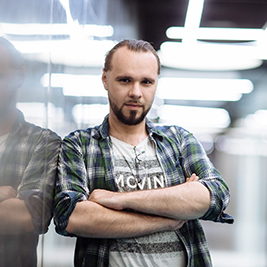Bank of Portraits / Omelianiuk Stepan and Maria

Omelianiuk Stepan and Maria
The Omelianiuks family lived on a farm not far from Matsiiv city (nowadays – Lukiv), Volyn region. There were five persons in their family. After the beginning of the war and occupation, the life of the family became worse. However, when in August 1942 Stepan saw two scared and bloodstained men in his barn, he harbored them without hesitation. Especially because he recognized his ex-coworker, a Jew Rubin Grosswer in one of them. A year before, yet during the beginning of the war, Stepan promised him assistance in case of need.
Another man, Leib Neimark, also was a Jew. Before the war, more than 2500 Jews lived in Matsiiv. The Jewish community was represented by more than half of the city’s population. It was quite typical for most cities of the Volyn and Rivne regions. During the interwar period, these regions were part of Poland and known as Volyn Voivodstvo. Among the two-million population of this administrative unit, about 200 thousand were people of Jewish origin. As usual, numerous Jewish communities dwelled in cities. Their representatives mostly were artisans or owners of small stores. After the beginning of the Second World War total number of Jews in Volyn enlarged because of refugees who flee from the Polish territories, occupied by Wehrmacht.
Everything changed after the beginning of the German-Soviet war. By the end of June 1941 Germans had occupied Volyn. The anti-Jewish actions, organized by the German occupational administration started. Particularly in Lutsk city, about 1500 Jews were shot dead in Liubart`s castle. In cities were created ghettos, where were relocated Jews from the cities and villages. They had to live there in conditions of poor sanitation, starvation, and poverty. Prisoners of ghettoes were forced to perform difficult or humiliating labor. Those, who weren`t capable of work, were shot dead outside the cities, near specially prepared places of the mass massacre. For Matsiiv Jews, such a place was prepared in the forest near the village of Ocunyniv and the Somynske Lake.
Rubin Grosser and Leib Neimark were among those few Jews who managed to survive. They were hiding in the sand ditches among the bodies of the murdered people for several hours. Later, they hid on the farm near the Hodovychi village, at Omelianiuk family dwelling.
For the short period, Stepan was hiding Rubin and Leib in the barn, secretly providing them with food, books, and newspapers. He arranged a shelter for them in the attic and made three hidden crawlways, through which they could get out the barn. First Omelianiuks was trying to keep the fact they were hiding Jews in secret even from their children. However, their daughter Lida learned about it by accident.
The assistance of children became necessary soon. Local Auxiliary policemen came to Omelianiuks` dwelling looking for Jews. They even managed to explore the barn where Rubin and Leib were hiding. They almost revealed the escapees, but Stepan persuaded them to leave. Though the danger was over then, nobody could be sure they won`t return. Leib Neimark afterward decided not to stay at Omelianiuks` and moved further. Rubin Grosser, however, remained there for more than a year. It was then when the assistance of Stepan`s 9-years-old son Dmytro came into use. Stepan asked him to bring Rubin supplies, in order to avoid extra attention to himself. Rubin Grosser, in return, was glad to help Omelianiuks. He worked on the field along with them, gathered and processed the grain. He performed all this work under Dmytro`s supervision, who watched around and warn him in case of danger.
Rubin Grosser had been hiding at Omelianiuks` dwelling up to the 1943 fall. Afterward, he joined the local Soviet partisan detachment. Later he was drafted into the Red Army.
He met Stepan and Maria again in 1944, after the expulsion of the Nazi occupants. After the end of the war, he moved to the USA. However, he did not forget about his rescuers. In 1960es they renewed communication.
On January 27 1982 the Yad Vashem organization posthumously awarded Stepan Omelianiuk and his wife, Maria an honorable title “Righteous Among the Nations”. Their son Dmytro obtained this reward in Israel in 1993. He dedicated his life to searching for information about Ukrainians who rescued the Jews during the Holocaust. By his efforts were revealed data about 800 people from the entire Ukraine, who assisted the people of Jewish origin during the German occupation. Among them were also people from his native Hodovychi village. During the war, they harbored 13 Jews. Four Hodovychi dwellers were awarded the title “Righteous Among the Nations”.

Maksym Milevskiy
Kyiv
National museum of the History of Ukraine in the Second World War
-
fingerprintArtefacts
-
theatersVideo
-
subjectLibrary


